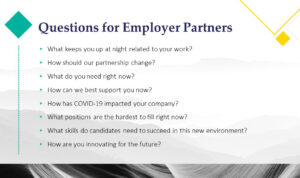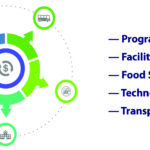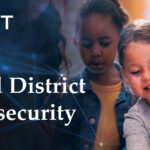Partnering with community employers and industry leaders is critical for higher ed’s future
Whether your college or university is faring well now, struggling to find the most effective pathway forward, or striving for future successes, a myriad of solutions and opportunities for thriving in today’s educational environment can assist you with reinvigorating your efforts. Here are the most critical strategies for your consideration:
- Reach out to current employer partners to listen and provide an opportunity for reflection. Learn what the pressure points are. Ask about what keeps employer leaders up at night in terms of their work. Consider ways to address burning employment and economic issues. Reflect on how partnerships should change considering the current and ever-changing environment.
- Align the institutions’ strengths with the needs of the employers. Now is the time for colleges and universities to focus deeper on workforce development efforts. Consider the top three programs and efforts that support and are congruent with the employers’ strategic plans and meet those needs.
- Create targeted marketing to evaluate options and offer innovative strategies. Focus on enhancing return on investment for students and families. Create a well-designed one-page document that can be tailored to specific employer needs and posted on your website to extend services to new potential partners. Take the time to reach out directly to new partners.
- Leverage partnerships with other higher education institutions by learning the top offerings of those institutions. Not everyone can do it all, so stay focused on what you do well and connect your higher education partners with your employer partners. Collaborate on virtual projects such as recruitment events.
- Promote scholarships, grants, and other funding sources that support employer needs. Employers may not be able to provide educational benefits as they once did to employees. Identifying related scholarships create a pathway for those who may not have considered returning to college.
 Review training, career advising, and coaching services. For employer partners who are hiring, training, laying off or furloughing employees, consider opportunities for providing services for employees to enhance their knowledge, skills, and abilities.
Review training, career advising, and coaching services. For employer partners who are hiring, training, laying off or furloughing employees, consider opportunities for providing services for employees to enhance their knowledge, skills, and abilities.
- Evaluate program offerings to ensure graduates are developing the latest in demand skills and are prepared to compete for newly created partner opportunities. Use market demand data including technical skills and essential skills to align programs and courses with current demand.
- Think beyond programs and consider research partnerships. What real world problems are employers facing and what resources at the college or university align? Use these opportunities to enhance students’ hands-on experiences and develop their real world expertise.
- Redesign courses to meet real world problems. A marketing class can assist a small business by developing a marketing plan or an advanced manufacturing course could work on developing a new tool or solving a problem. Work with faculty to consider ideas and connect faculty as well as students with partnerships.
These strategies are a solid foundation for developing partnerships that will be of interest to students, promote recruitment, retain current students and drive them to completion and on time careers that will change their lives.
For universities who serve traditional-age, on-campus students, these partnerships will require a shift to accommodate local adult students, many of whom are working and managing other aspects of their lives. Ensure the focus is on learning regardless of place and time.
A strong education consultant can offer proven recommendations to leverage assets and reduce deficiencies to chart a course forward in this new higher education environment. Our team is well-versed in partnering with universities and colleges to provide an organizational review which often includes looking at your student enrollment, student experience, demographics, and strategy for future growth within the local market.
We also have the tools and resources to identify market saturation, occupational gaps, hot and emerging skills, as well as potential partnership opportunities. There’s no better time to reassess policies and programs to find the pathway to success for students in this ever-changing environment.










